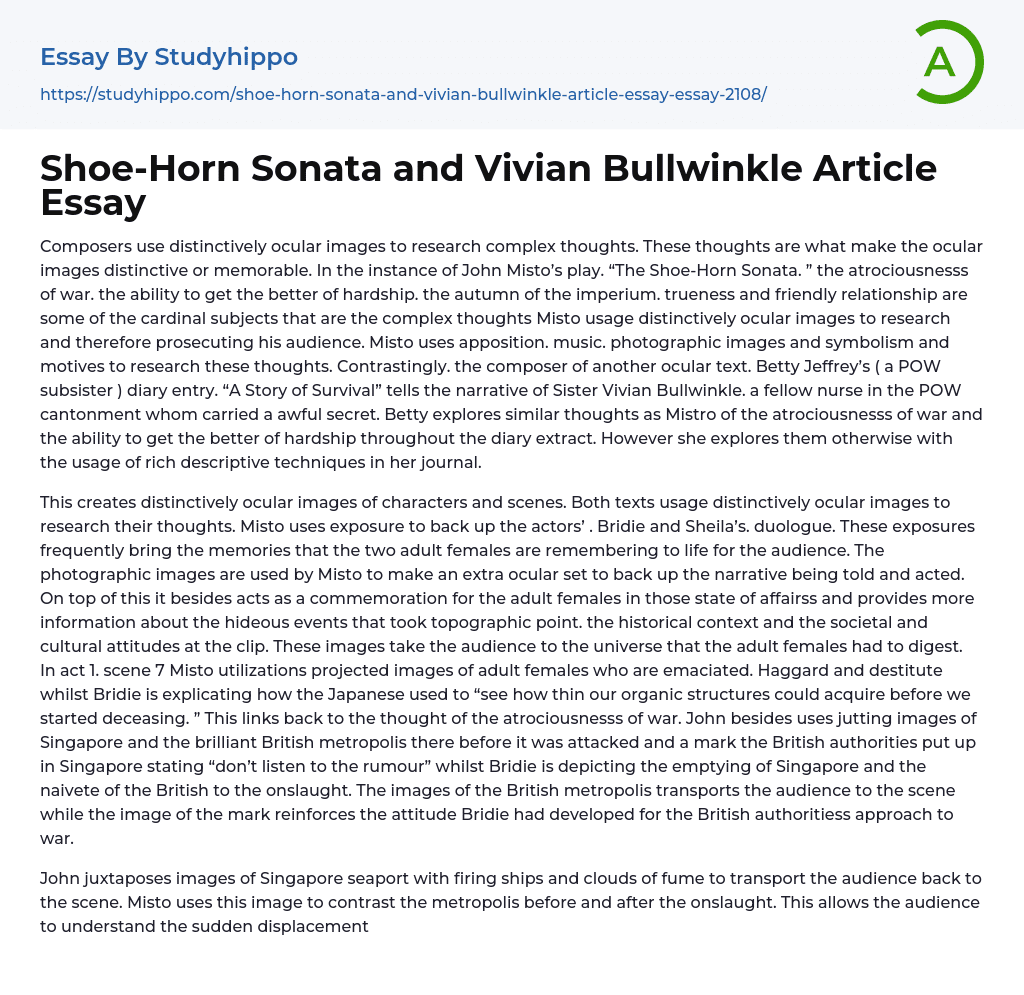Composers utilize visual imagery to delve into complex ideas that make the images memorable. John Misto's play, "The Shoe-Horn Sonata," explores themes of war atrocities, resilience, the fall of empire, loyalty, and friendship. Misto employs juxtapositions, music, photographs, symbolism, and motifs to investigate these themes visually, engaging his audience. In contrast, Betty Jeffrey's diary entry, "A Story of Survival," which tells Sister Vivian Bullwinkle's harrowing tale of survival as a POW nurse, also grapples with war atrocities and resilience. However, Jeffrey uses rich descriptive techniques in her journal to create distinct visual imagery of characters and scenes. Both texts rely on visual imagery to explore their ideas, with Misto using photographs to support his actors' dialogue and bring their memories to life for the audience.Misto incorporates photographic images to augment and memorialize the narrative and soci
...al context presented in his play. These images provide additional insight into the horrific events that took place, including the historical and cultural attitudes at the time. They allow audiences to empathize with the struggles endured by women in wartime conditions. In Act 1, Scene 7, Misto uses projected images of emaciated and destitute women while Bridie explains Japanese cruelty towards prisoners of war. Displaying the brilliant British city of Singapore before and after it was attacked, as well as a government propaganda poster urging civilians not to believe rumors, reinforces Bridie's attitude towards war's political handling. Juxtaposing imagery of undamaged Singapore next to explosions at the harbor provides contrast between the city before and after its destruction.The sudden displacement from security to pandemonium experienced by the audience is now understandable thanks to Misto’s play. The autumn of the imperiu
is explored, while Jeffrey uses rich descriptive techniques to investigate thoughts on the atrociousnesss of war. Vivian’s experience is recounted by her as she describes the slaughter of ground forces nurses and her survival. Her story has been brought to life through Jeffrey’s use of visual imagery. Misto uses a range of techniques, including projected imagination, extracts from 1940s songs, and vocal and instrumental music, to allow the audience to connect with the characters and feel the emotions of the play. This not only adds variety and emotional subtext but also places the scenes in their historical context and demonstrates the power music can have over one’s emotions.Misto has utilized various techniques to explore the themes of overcoming hardship, friendship, and loyalty in the play. One such technique is the use of music as a medium to create visually striking images. A perfect example is the soundtrack that starts with distant singing but gradually gets louder, featuring 20 to 30 men singing 'O. Come All Ye Faithful.' This is played while Bridie explains Christmas time and shows the audience how to find joy even in the face of adversity. The same soundtrack also featured 'The Blue Danube' as Sheila and Bridie recount how they were entertained by the Japanese army brass band on the day they were released, signifying a happy time and the end of war.
In contrast, Jeffrey has used rich descriptive techniques to examine the concept of overcoming hardship. Betty explains how Vivian survived in the jungle for ten days, aided by a river she found and a small native colony with the soldier she was searching for. Jeffrey's use of detail creates
a vivid mental picture in the audience's mind of what Vivian had to endure to survive.
Moreover, Misto has employed symbolism and motifs to probe the themes of friendship and loyalty in the play. The play's title is significant in this regard.In "The Shoe-Horn Sonata", the recurring motif of the shoe-horn represents the loyalty and friendship between Bridie and Sheila. As the shoe-horn appears, its significance is reinforced by Misto's use of the sound of crickets in the background, highlighting Sheila's hidden secret. It is eventually revealed that Sheila sold herself, not the shoe-horn, to save Bridie's life. This act of selflessness demonstrates the true bond between the two women. The shoe-horn also plays a vital role in saving Sheila's life during their time in the South China Sea, and it serves as a musical instrument for the choir, further strengthening their bond through adversity. The shoe-horn's symbolism is ultimately realized at the end of the play, when Sheila reunites with Bridie and offers her the shoe-horn as a symbol of their renewed friendship. Other tokens of their loyalty include the chop bone and caramel. Jeffrey's description of Vivian and the women in the POW camp highlights their deep bond and loyalty, evident in their strict prohibition of discussing Bullwinkle's story during the war to prevent anyone from being killed.John Misto utilized symbolic representation to delve into themes of camaraderie and loyalty, while Jeffrey employed a vivid descriptive approach to create distinct visual imagery of the setting and characters. Key elements utilized by Misto in his play to produce memorable and visually engaging representations of intricate ideas incorporate the implementation of projected images, symbolism, motifs, juxtaposition,
and music. When compared to Misto's techniques, Betty Jeffrey also implemented a similar descriptive approach to explore analogous themes, creating visually engaging imagery of the characters and setting to captivate viewers and make a lasting impact with the narrative.
- Band essays
- Baroque Music essays
- Blues essays
- Classical Concert essays
- Classical Music essays
- Concert essays
- Hip Hop essays
- Jazz essays
- Ludwig Van Beethoven essays
- Michael Jackson essays
- Mp3 essays
- Music Concert Report essays
- Music Reference essays
- Music video essays
- Musical Instruments essays
- Opera essays
- Piano essays
- Popular music essays
- Recording essays
- Rock And Roll essays
- Rock Music essays
- Singing essays
- Sonata essays
- Song essays
- Sonnet essays
- Tupac shakur essays




